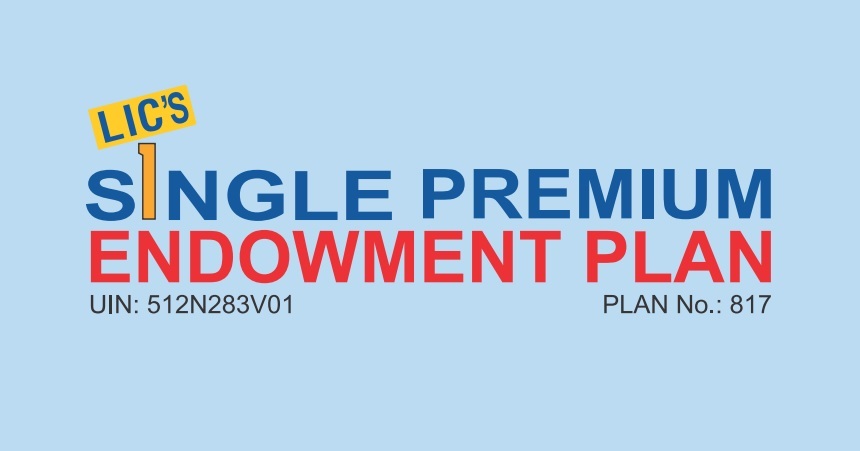LIC Single Premium Endowment Plan (Table no. 817) is a single premium non-linked participating life insurance plan. It is not a new plan. The plan has been around for a long time.
A reader asked me to review the plan. So, here we go.
LIC Single Premium Endowment Plan (Table no. 817): Review
- Minimum Entry Age): 90 days
- Maximum Entry Age: 65 years
- Minimum Age at Maturity: 18 years
- Maximum Age at Maturity: 75 years
- Minimum Policy Term: 10 years
- Maximum Policy Term: 25 years
- Minimum Basic Sum Assured: Rs.50,000
- Maximum Basic Sum Assured): No limit
- Premium Payment Term: Single Premium. You need to pay the premium just once.
- You can take a loan against this policy.
Please visit LIC website for more information about the policy features.
LIC Single Premium Endowment Plan: Maturity Benefit
Quite in line with what we have seen with other endowment plans.
Maturity Benefit = Sum Assured + Vested Simple Reversionary Bonus + Final Additional Bonus
Simple Reversionary Bonus is announced every year but paid at the time of maturity. Till maturity, the simple reversionary bonus accumulates (with no compounding).
Let’s suppose you purchased the plan with a Sum Assured of Rs 10 lacs. If Simple Reversionary Bonus of Rs 40 per thousand Sum Assured is announced by LIC, this means Rs 40,000 (Rs 40/1000 * 10 lacs) will be added to your corpus that year.
If the policy term is 20 years and the bonus remains at the same level throughout your policy term, you will accumulate Rs 8 lacs (Rs 40,000 X 20 years).
Final Additional Bonus (FAB) is applicable only in the year of maturity/death. Assuming FAB of Rs 200 per thousand Sum Assured in announced in the year of maturity, you will get Rs 2 lacs (Rs 200/1,000 X 10 lacs) as FAB.
Total maturity amount = Rs 10 lacs + Rs 8 lacs + Rs 2 lacs = Rs 20 lacs
Please understand I have picked up the bonus numbers just to show how maturity amount can be calculated. Maturity benefit won’t be Rs 20 lacs in all the cases.
LIC Single Premium Endowment Plan: Death Benefit
The calculation is same as for maturity benefit.
Death Benefit = Sum Assured + Vested Simple Reversionary Bonus + Final Additional Bonus
What will be the returns like?
As for any traditional plan, you can expect returns to be in the range of 4-6% per annum.
Of course, the returns will depend on the age of the policyholder at the time of policy purchase.
I can go into return calculation. However, there is an even bigger problem that you need to look at.
Maturity proceeds LIC Single Premium Endowment Plan (817) are taxable
The life insurance premium is eligible for deduction under Section 80C only to the extent of 10% of the Sum Assured. Sum Assured, in this case, means minimum death benefit.
In a single premium plan, since you pay the premium just once, the Sum Assured is likely to be a lower multiple of the Single Premium instalment.
For instance, the premium for a 30-year-old male for Sum Assured of Rs 10 lacs (20-year policy term) will be approximately Rs 5.5 lacs. You can try out LIC Premium Calculator to check the premium in your case.
Only the premium to the extent of Rs 1 lac (10 lacs X 10%) will be eligible for deduction under Section 80C. Again, this is subject to Section 80C benefit cap of Rs 1.5 lacs per financial year.
This is not the end of your worries.
If the premium is greater than 10% of Sum Assured (minimum death benefit), the maturity amount is taxable. This is as per Section 10(10D) of the Income Tax Act.
Please understand only the maturity benefit is taxable. The death benefit is still exempt from tax.
As we checked earlier, the premium is much higher than 10% of Sum Assured in LIC Single Premium Endowment Plan. Therefore, the maturity amount in LIC Single Premium Endowment plan is taxable.
Do note this is a problem with almost all single premium insurance plans.
A few single premium life insurance plans circumvent this problem by defining Death Benefit as at least 10 times the Single Premium. LIC Jeevan Utkarsh is a case in point. However, it is about give and take. You can expect pre-tax returns from LIC Jeevan Utkarsh to be lower since extra money will go towards mortality charges.
Read: Why Senior Citizens should avoid life insurance plans?
PersonalFinancePlan Take
Like any other traditional life insurance plans, I will advise you to stay away from this plan.
Nothing against LIC. Traditional plans (including the ones from the private insurers) provide low life cover and poor returns. In addition, the surrender penalty is quite high.
LIC Single Premium Endowment plan comes with an additional problem that the maturity proceeds are taxable.
Do not fall into the trap of paying the premium just once and enjoying life cover and investment benefits for many years.











5 thoughts on “LIC Single Premium Endowment Plan (817): Review”
Hi, I am contemplating making this policy for my 0 year old son with a sum assured of 10,00,000, my single premium is coming to around 5,70,000approx for an 18 years term. Total maturity amount is showing as 18,00,000approx. Is it advisable? In terms of tax? Please let me know. This is rather urgent sir. Thank you.
In my opinion, this is not advisable.
Better purchase a term plan on your life. You can purchase that from LIC itself.
Invest in PPF or mutual funds for son’s education.
SIR I INVEST RS. 191000 TO LIC SINGLE ENDOWMENT PLAN. SO I AM RECEIVED REBATE UNDER SECTION 80C OF INCOME TAX
Hey, i am planning to invest 50k for 10 years in this. Is it advisable or bank fd is better option in this.
Sir , can I prematurely withdraw money if I need any financial problem under this (817) scheme